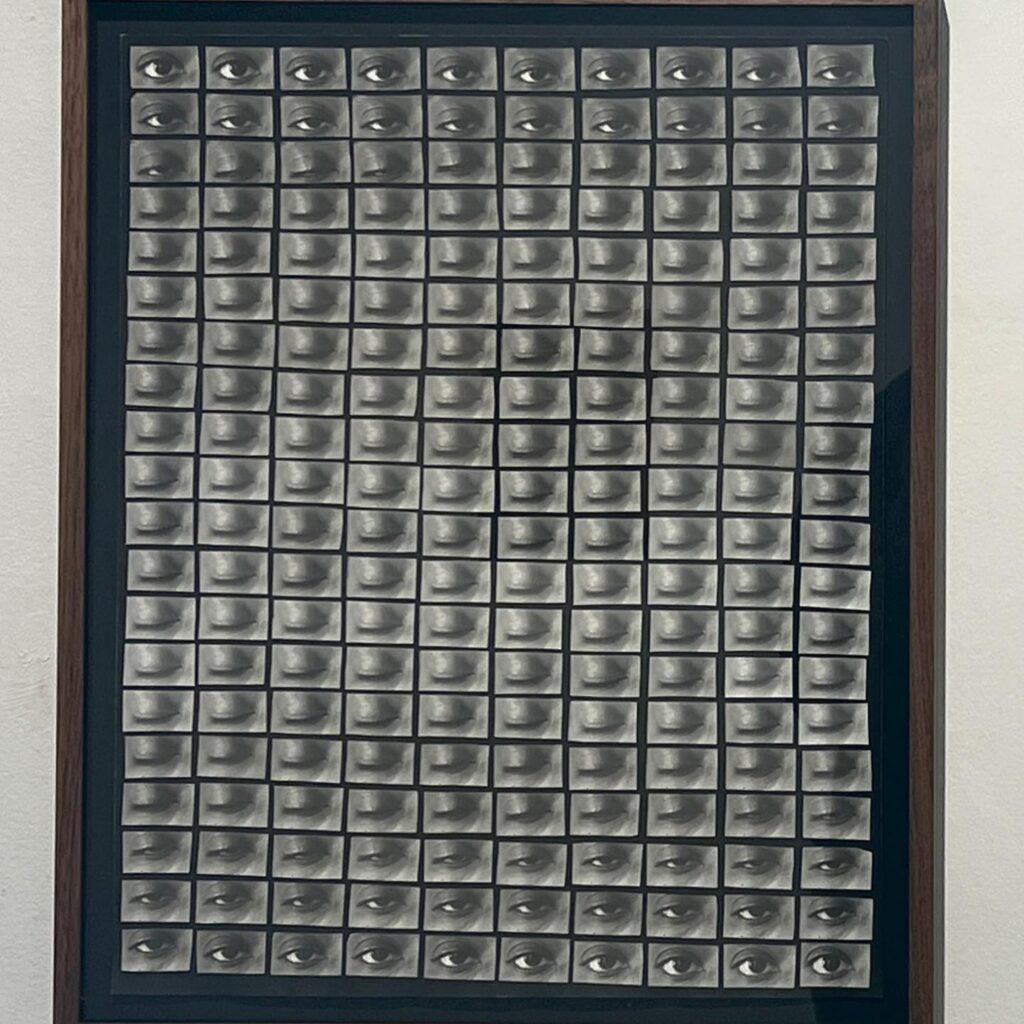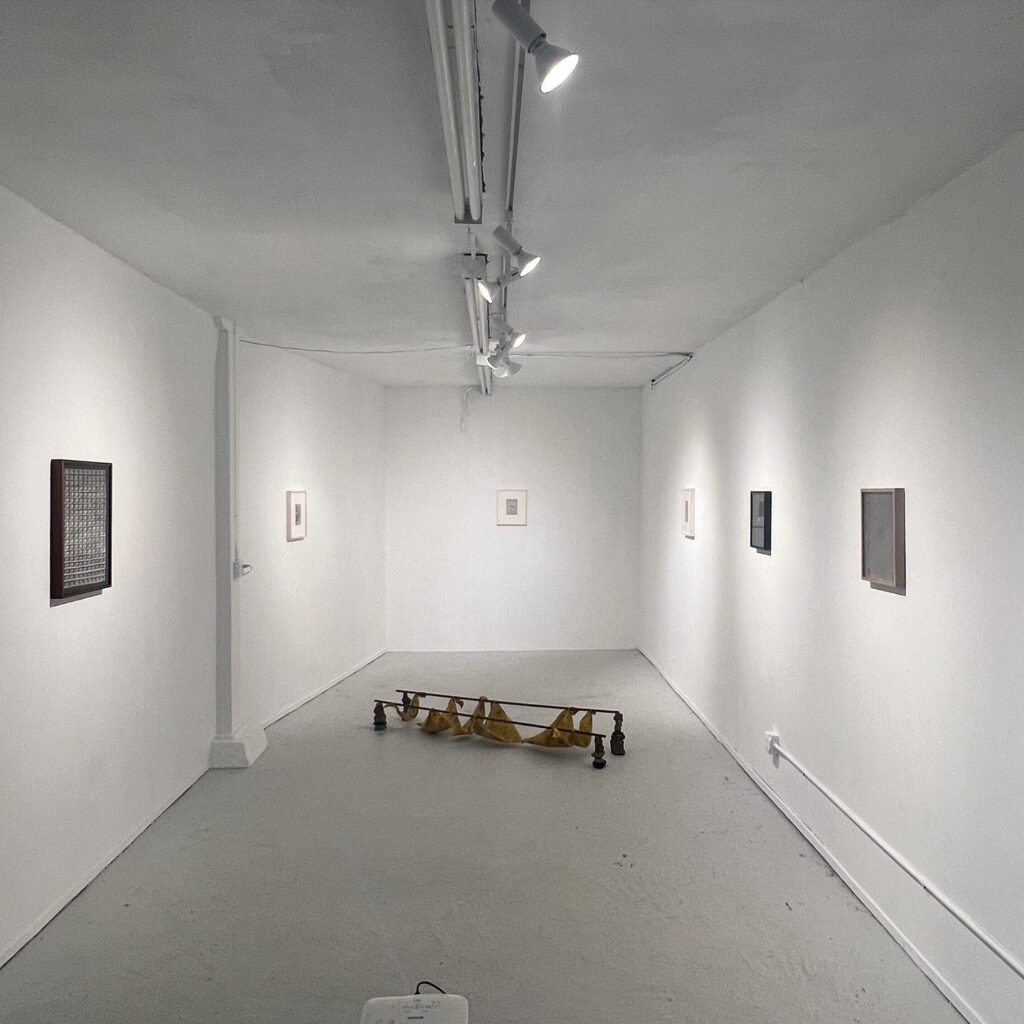Sounds of fluttering birds and gravel crunching underfoot build a sonic atmosphere within the photographic, collage, sculptural, and video work in Ohio-based artist Dionne Lee’s solo show, Castings (through April 2 at Et al. Gallery). This ambiance transports the viewer from the bustling of San Francisco’s Chinatown neighborhood outside the gallery into a liminal space at the intersection of youthful wonder, ancestral memory, and the wake of colonialism.
An unmarked door yields entry into Et al., through a long hallway, where faint sounds of footsteps crunch leaves and birds chirp. At the end of the hallway a set of stairs appears to usher viewers into the basement gallery. Before descending into the gallery below, the viewer is greeted by Generational eye, generational I, a video projected in a lofted shelf above the stairs.
The black-and-white video begins with a shot of a stone surrounded by grass. A hand overturns the rock, revealing earth beneath. Molded to the underside of the stone, the concave soil is an index of the stone’s former presence. The tight frame focuses the viewer’s attention on the oval shape of the compacted soil, resembling an eye socket. Perhaps it is an ancestral eye embedded in the soil, the grass, the snow, the leaves, the land, persisting through the seasons, but one also inside the person filming and the person watching. The work alludes to this idea within the title’s wordplay between “eye” and “I,” cleverly guiding the viewer to think critically about how the experiences of one’s ancestors mold and shape one’s identity.
The video concludes by depicting two hands pressed together; each finger takes a turn rotating slowly, starting with the pinky finger and moving towards the thumb. With each transition adjacent fingers gently sway—a reminder of the complicated network of nerves and tendons that make it difficult to move these fingers independently. This gentle choreography evokes the translation of inheritance, be that physical or psychological, of generations past. Lee cites My Grandmother’s Hands by Resmaa Menkem as a reference for this video. That book describes how trauma, including generational trauma, settles in the joints. Therefore, the slow rotation of each joint is a ritual to dispel trauma from the body.

Guided clockwise around the gallery, the viewer approaches the series of black-and-white photographs titled Castings. Two arms bow out into the center of the frame with fingers extended. The pose suggests that these hands have set something in motion. They are a catalyst. The second photograph in the series captures a stone in mid-air. Upon first glance, the second and third photographs in the series appear identical. Though, on second glance, the first is a falling rock while the latter depicts its shadow approaching the ground beneath. Through the tactics of composition, perspective, and seriality, Lee evokes the momentum and gravity of inheritance as well as the simple sweet satisfaction of letting an object fall from one’s hands. Lee offers this gesture as a form of research, offering a lesson in survival.
These survival lessons echo throughout the exhibition. In Untitled copy of an improvised stretcher, two long wooden dowels rest atop four stacks of rocks. The composition of these stones resemble cairns, alluding to burial mounds and marking this sculpture as a site. The heads of dandelion flowers are compressed in the space between the wood and stone. Six cloths are draped between the wooden dowels. The fabric is dyed deep yellow with marigold petals. Both marigolds and dandelions used in this sculpture are part of the taxonomic order Asterales, but marigolds are native to the Americas while dandelions are an invasive species from Eurasia. Through the convergence of these species in the sculpture, Lee traces a complex history of colonial influence. The cloth hovers above the floor of the gallery, tracing the contours of an absent body.

Lee references a diagram of a stretcher from the Girl Scouts of America used to teach young women how to carry their companions out of the woods. This work teeters between youthful adventure/whimsy of the woods and the harsh reality of danger. This paradox is ingrained into the bedrock of the American landscape.
Castings offers a practice of playful rituals that seek answers from kin embedded in the soil beneath. Lee unearths ancestral memories and tactics to overcome the weight of generational trauma. Through conceptually driven video, collage, and photographic work, Lee provides poignant lessons in survival, letting go, and remembering.
DIONNE LEE: CASTINGS runs through April 2 at Et al. gallery, SF. More info here.





